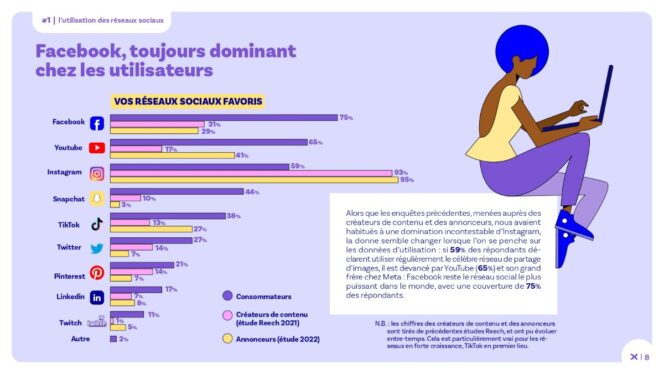Reech just released the seventh edition of his studio dedicated to influencer marketing. In collaboration with the polling institute Norstat, 11,011 social network users were polled during the month of December 2022. The goal of this year’s study: to understand consumer expectations and the connection they have with content creators.
Key figures and important facts to remember in 2023
- Users spend an average of 1h42 a day on social networks (16% of respondents spend more than 3 hours a day),
- 75% of users are present on Facebook, making it the most popular platform among Internet users,
- YouTube is one of the few transgenerational networks, with content adapted to every age group,
- Pinterest is used more by women (27% of women vs 14% of men), while Twitch is more frequented by men (15% of men vs 8% of women),
- 47% of users use the word “influencer”compared to the 11% who use the term ” content creator “,
- The most followed content creators are the “food” influencers,
- Reality TV stars account for 31% of content creators followed by internet users,
- 66% of respondents indicate that there is a need to evolve the influence sector towards a more ethical model.
Facebook dominates among users, but not among content creators
The study highlights an interesting fact: the social networks preferred by users are not the same ones preferred by content creators!
Here are the top 5 consumer-favorite social networks:
- Facebook : with 75% of users having an account, compared to 31% of content creators,
- Youtube : 65% for users, versus 17% for creators,
- Instagram: 59% for users, compared to 93% for creators,
- Snapchat: 44% for users, versus 10% for creators,
- tick tock: 38% for users, compared to 13% for creators.
Note that the use of social networks is generational. Thus TikTok is used by 81% of the under 24s (against 15% of the over 65s), and Facebook by 84% of the over 35s (against 38% of the 18-24 year olds).

Increasingly influential content creators, driven by algorithms
During the survey, 32% of respondents indicated that they follow a content creator on social networks (rising to 63% for Gen Z). On the other hand, 44% of respondents also confirmed that they have seen content from creators without being a subscriber. A discovery that demonstrates how the algorithms of social platforms play an important role in the distribution of content.
Here are the 5 most popular themes on Instagram:
- Food: 48% of respondents say they follow a content creator in this area,
- Humor : for 47%,
- Beauty and cosmetics: for 45%,
- Travel : for 41%,
- Fashion : for 40%.

In addition, these content creators allow social network users to:
- Discover new products and services (59%),
- Help compare products for a future purchase (41%),
- Motivate to form new habits (36%).
Another interesting fact: to the question “What are the two media you absolutely could not live without? »36% of respondents cited influencer accounts on social networks (compared to 39% for accounts of their own relatives).

Partnerships, accepted but deemed too numerous
In recent years, partnerships between content creators and advertisers have flourished widely on social networks and in different forms. Among the types of partnerships most appreciated by consumers we find:
- Promo Codes (57%),
- Competition games (45%),
- Product presentations (41%),
- Product testing (35%),
- Product placement (24%).
The number to remember: 73% of users have already purchased a product after seeing a partnership on social networks. Furthermore, the types of products most purchased through partnerships were cosmetics among women (72%) and high-tech products among men (47%).

At the same time, 73% of respondents indicate they are saturated with partnerships (40% for a minority of creators, versus 26% for the majority and 7% for all or nearly all influencers).
To conclude, 2023 could also be marked by major changes in the field of flu: 66% of respondents indicate that it is necessary to evolve the flu sector towards a more ethical model!








Comments
Post a Comment